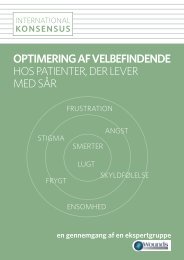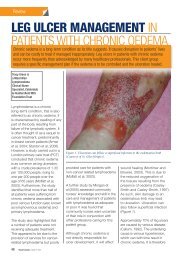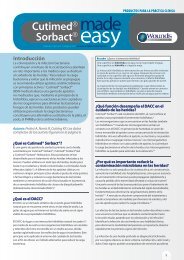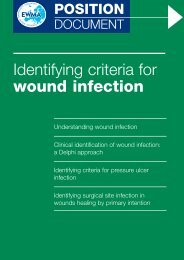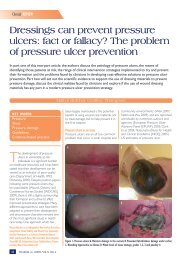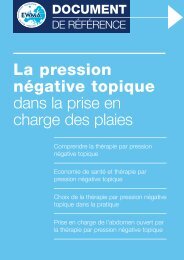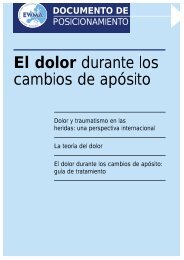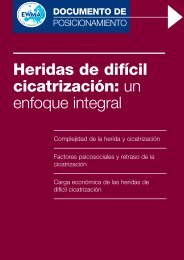VIEW PDF - Wounds UK
VIEW PDF - Wounds UK
VIEW PDF - Wounds UK
- No tags were found...
Create successful ePaper yourself
Turn your PDF publications into a flip-book with our unique Google optimized e-Paper software.
CASE REPORTSpinal cord injury:using maggots to ease the pressureAnne Cullen is Community Staff Nurse, LarkhallHealth Clinic LanarkshireIt is estimated that about 2,000 peoplesuffer traumatic spinal cord injury everyyear in the <strong>UK</strong> (National Spinal Cord InjuryStatistical Center, 2008) resulting in a loss orimpaired function causing mobility or feelingto be reduced.Patients who have had an SCI mayhave many secondary conditions tocontend with, including flaccid bladder,poor bowel management, depressionand neuropathic pain. One of the mostcommon secondary complicationsare pressure ulcers (McKinley, 1999).Following an SCI there can be changesin sensation and muscle tone. The supplyof blood to the subcutaneous tissueand skin can be altered which leads to achange in the normal elastic nature of thetissue underlying the skin. This producesincreased stiffness and alteration to thevascular supply reducing the skin’s ability towithstand pressure (Atiyeh et al, 2005).In the community the management ofpatients with SCI-related pressure ulcerscan often be challenging. These patientsare usually bed-bound and the pressureulcer can take some time to heal. Healthprofessionals must assess the patientholistically not only taking into account theirphysical health but also their psychologicalwell-being.Preparation of the wound bed and thedebridement of sloughy or necrotic tissueare essential if the wound is to heal quickly.Some larger pressure ulcers can take aslong as a year to heal using conventionalmethods of debridement.The reintroduction of maggot therapyto remove necrotic tissue has reportedlybeen very successful when treating SCIpatients with pressure ulcers. Shermanet al (1995) stated that out of the eight82 <strong>Wounds</strong> <strong>UK</strong>, 2009, Vol 5, No 1patients with SCI-related pressure ulcerstreated with maggot therapy, most of thenecrotic wounds were debrided within oneweek and wound healing was more rapidwhen using maggot therapy than whenusing the conventional treatments. Maggottherapy is said to be significantly moreeffective and efficient than these othermethods. Sherman et al (1995) describedthe use of maggot therapy as safe, simpleand inexpensive.Case reportPatient historyThe patient was a 43-year-old manwho lived with his partner and her13-year-old son. His past medical historyincluded being born with one kidney,hypertension, insertion of aortic stent andpulmonary oedema.In 2006 the patient presented at A&Ewith sudden onset of interscapular backpain. He was admitted into the surgicalintensive care unit post-insertion of anaortic stent for a dissection of an aorticaneurysm. A computed tomography (CT)scan confirmed spinal cord infarctionresulting in T8 paraplegia meaning the SCIwas on the eighth thoracic vertebra. T1 toT8 paraplegics have injuries in one of thefirst eight thoracic bones, and as a result arenot able to use their legs. They also havepoor trunk control, though they usuallyretain good hand control. This patient wastransferred to the spinal injuries unit afterbeing extubated.After eight months of rehabilitation he wasallowed to go home. He had a supra-pubiccatheter inserted due to his flaccid bladder.He also had to manually evacuate hisbowels on a daily basis. This procedure tookat least half an hour to carry out. To aid himin his bowel care he was prescribed Sennaand Lactulose. The patient managed hisbowel care quite well but on occasionally heexperienced accidents. These episodes werebecoming more frequent, causing someembarrassment to him and subsequentlystopping him from leaving home, which washaving a huge impact on his family life.Figure 1.This is the wound at the initialassessment. It has extensive areas of full-thicknessskin loss and destruction to the tissue. Thesurrounding skin was red, inflamed and maceratedin areas due to extensive amounts of exudatecoming from the wound. One side of the buttockhad an undermining sinus.It was suggested by his GP that theformation of a colostomy could make hisbowel management much easier. After someconsideration the patient agreed to this.After the colostomy was formed the patientsuffered some complications and his bowelbecame badly infected. Further surgery tookplace and a new colostomy procedure wasnecessary. During this time in hospital thepatient developed a large pressure ulcer tohis sacral area (Figure 1).Following his discharge from hospital hiscare was taken over by the long-termconditions team (made up of districtnurses). During the initial assessmenthe explained that he was experiencingneuropathic pain, which is described by theSpinal Injury Network (2004) as a significantproblem for some SCI patients. To help withthis problem the patient’s GP prescribedgabapentin (600mg) three times daily and
CASE STUDYwas healing which helped to lift his moodconsiderably. By April 2008 the woundhad healed significantly with only one areawhere the slough remained. One moreapplication of maggots was used and thisdebrided the wound bed completelyallowing the wound to heal much quickerthan was initially expected (Figure 3).After only four months and just threetreatments of maggot therapy the woundwas completely healed on one side ofhis sacrum, and reduced to 2cm x 2cmwith a depth of approximately 2cm (Figure4). The patient was confident in the factthat he could get out of bed for shortperiods at a time, giving him a much betterquality of life.It is essential when using maggot therapythat the surrounding skin is assessed as theenzymes responsible for cleaning the woundcan cause maceration to the healthy tissuearound the wound. To protect this skinSudocrem (Forest Laboratories, Bexley) wasapplied around the margins of the wound.Regular wound swabs were taken to ensureno infection was present which could delaythe healing process, although it has beenreported that maggot therapy also helpsto combat infections such as methicillinresistantStapylococcus aureus (MRSA) andalso Pseudomonas aeruginosa (Parnes et al,2007). The aim of regular wound swabbingwas to detect any infection quickly in orderto prevent any delays to healing.DiscussionMaggot therapy is effective as it promotesrapid cleaning of the wound by removingnecrotic and sloughy tissue. It can alsocontrol the production of offensive odoursproduced by some bacteria, as well ascontrolling infection. After ingesting microorganisms,the maggots then go on to digestthese micro-organisms causing the maggotsto secrete chemicals such as allantoin,which has broad spectrum antibacterialproperties. The maggots promote thehealing process by eating the necrotic tissueand stimulating production and granulationof new healthy tissue.There have been many papers publishedon the use of maggot therapy which discussthe use of maggots to debride and healwounds in not only SCI but also diabeticfoot ulcers. Using maggot therapy has beenshown to be a positive experience for bothpatients and health professionals (Lodge etal, 2006).In this case one application of maggottherapy produced significant improvements,and after only three applications the woundhad practically healed. When the maggotshad removed enough of the slough tomove on to another method of healing,Promogran Prisma (Johnson and JohnsonWound Management, Ascot) was usedwhich is designed to provide protection andgrowth by addressing continuous changes inthe wound micro-environment.By using maggot theapy the cost to theNHS can be greatly reduced. Thomas(2006) states that the saving to the NHS ofusing maggot therapy to debride woundsand promote quicker wound healing couldbe as much as £200m per annum.The use of maggots in this instancepromoted wound healing by removingthe sloughy areas quicker than any otherproduct that we tried (such as silverdressings). Although the other productsused did lift the sloughy areas the processwas slow and the patients holistic well-beinghad to be considered. He was becomingincreasingly more depressed at the lengthof time the wound was taking to heal. Thisprompted the return to maggot therapy.As stated previously SCI patients havemany complications to contend with. Whenpressure ulcers form, it is important tohelp them heal as quickly as possible as thiswill greatly improve the patient’s qualityof life. This is hugely beneficial to both thepatient but also to the NHS and healthcareprofessionals. W<strong>UK</strong>ReferencesAtiyeh BS, Hayek SN (2005) Pressure soresassociated spasticity: a clinical challenge. IntWound J 2(1): 77–80Bunkis,J Gherini, S, Walton RL (1985) Maggottherapy revisited. West J Med 42: 554–6Hess CT, Kirsner RS (2003) Orchestrating woundhealing: Assessing and preparing the wound bed.Adv Skin Wound Care 16(5): 246–57Lodge A, Jones M, Thomas S (2006) Maggot‘n’ chips: a novel approach to the treatment ofdiabetic ulcers. Br J Community Nurs 11(12):suppl 23–6Mckinley W, Jackson A, Cardenas D, DeVivo M(1999) Long term medical complications aftertraumatic spinal cord injury: A regional modelsystem analysis. Arch Phys Med Rehab 80: 1402–9National Spinal Cord Injury Statistical Center(2008) http://www.spinalcord.uab.edu/show.asp?durki=21446 (Last accessed May 11 2008)Sherman RA, Wyle F, Vulpe M (1995) Maggottherapy for treating pressure ulcers in patientswith spinal cord injury patients. J Spinal CordMed 18(2): 71–4Parnes A, Lagan KM (2007) Larvaral Therapyin Wound Management. Rev J Clin Pract 61(3):488–93Spinal Injury Network (2004) http://www.spinalinjury.net/sci-pain.htm(last accessed May 15th2008)Thomas S (2006) The cost of managing chronicwounds in the <strong>UK</strong> with particular emphasis onwound debridement. J Wound Care 15(10): 465–9Case reportsIf you have a case report that you would like to see published in <strong>Wounds</strong> <strong>UK</strong>, Please contact Nicola Rusling,Managing Editor, at nicola@wounds-uk.com for further information<strong>Wounds</strong> <strong>UK</strong>, 2009, Vol 5, No 185




